


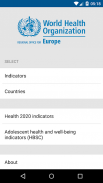
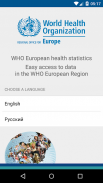
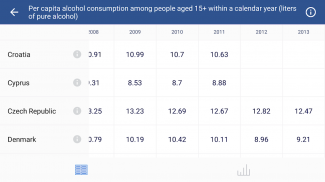
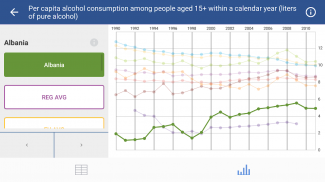
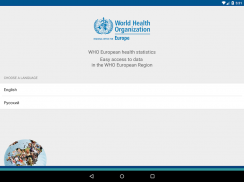
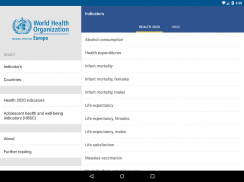
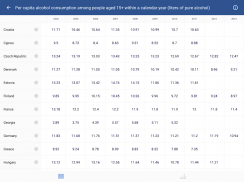
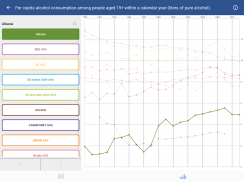
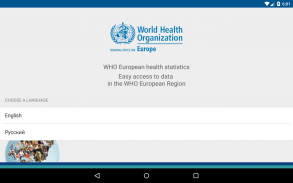
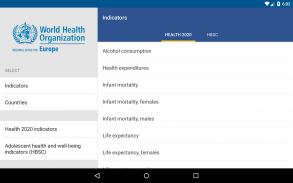
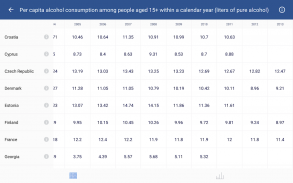
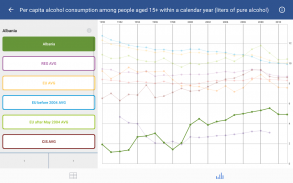
WHO/Europe health statistics

คำอธิบายของWHO/Europe health statistics
Easy access to data in the WHO European Region
This app was developed by the Division of Information, Evidence, Research and Innovation at the WHO Regional Office for Europe. It provides easy access to the data underlying two reports on the health and well-being in the European Region. More details are available in the “Further reading” section.
The European health report 2015 describes the health situation of the European Region and progress towards the targets of WHO’s Health 2020 policy. The app presents Health 2020 core indicators, which were agreed by the WHO European Region Member States for monitoring progress towards the Health 2020 targets. Some of these indicators are based on official WHO sources and other are based on non-WHO sources, such as UNESCO and UNDP. Data from WHO sources can be accessed and queried at national level, while data from non-WHO sources is available in aggregated form, for groups of Member States.
The 6th international report from the WHO collaborative study - the Health Behavior in School-aged Children survey (HBSC) – published in 2016 presents the 11-, 13- and 15-year-old boys' and girls' health and well-being, social environments and health behaviors, as well as the health inequalities many of them face. Data in the app displays results of a statistical significance of differences between boys and girls, and statistical significance of indicators associated with family affluence.
Further information: DIR@euro.who.int
ง่ายต่อการเข้าถึงข้อมูลในองค์การอนามัยโลกภูมิภาคยุโรป
app นี้ได้รับการพัฒนาโดยกองสารสนเทศหลักฐานการวิจัยและนวัตกรรมที่สำนักงาน WHO ในภูมิภาคยุโรป จะให้ง่ายต่อการเข้าถึงข้อมูลพื้นฐานสองรายงานเกี่ยวกับสุขภาพและความเป็นอยู่ในภูมิภาคยุโรป รายละเอียดเพิ่มเติมมีอยู่ในส่วน "อ่านเพิ่มเติม"
รายงานสุขภาพยุโรป 2015 อธิบายถึงสถานการณ์สุขภาพของภูมิภาคยุโรปและความคืบหน้าไปสู่เป้าหมายของสุขภาพ 2020 นโยบายผู้ที่ นำเสนอแอพพลิเคสุขภาพ 2020 ตัวชี้วัดหลักซึ่งได้รับความเห็นชอบจากประเทศสมาชิกองค์การอนามัยโลกภูมิภาคยุโรปเพื่อติดตามความคืบหน้าต่อสุขภาพ 2020 เป้าหมาย บางส่วนของตัวชี้วัดเหล่านี้จะขึ้นอยู่กับแหล่งที่มาขององค์การอนามัยโลกอย่างเป็นทางการและอื่น ๆ ที่อยู่บนพื้นฐานของแหล่งที่ไม่ใช่ใครเช่นยูเนสโกและ UNDP ข้อมูลจากแหล่งข้อมูลที่สามารถเข้าถึงได้และสอบถามในระดับชาติในขณะที่ข้อมูลจากแหล่งที่ไม่ใช่ที่เป็นอยู่ในรูปแบบที่รวบรวมสำหรับกลุ่มประเทศสมาชิก
รายงานต่างประเทศที่ 6 จากการศึกษาความร่วมมือองค์การอนามัยโลก - พฤติกรรมสุขภาพในวัยเรียนการสำรวจเด็ก (HBSC) - ตีพิมพ์ในปี 2016 ที่มีการจัด 11- 13 และเด็กชาย 15 ปีและหญิงสุขภาพและความเป็นอยู่ที่ดี สภาพแวดล้อมทางสังคมและพฤติกรรมสุขภาพเช่นเดียวกับความไม่เท่าเทียมกันด้านสุขภาพมากของพวกเขาใบหน้า ข้อมูลในแอปแสดงผลของนัยสำคัญทางสถิติของความแตกต่างระหว่างชายและหญิงและนัยสำคัญทางสถิติของตัวชี้วัดที่เกี่ยวข้องกับความมั่งคั่งของครอบครัว
ข้อมูลเพิ่มเติม: DIR@euro.who.int
























